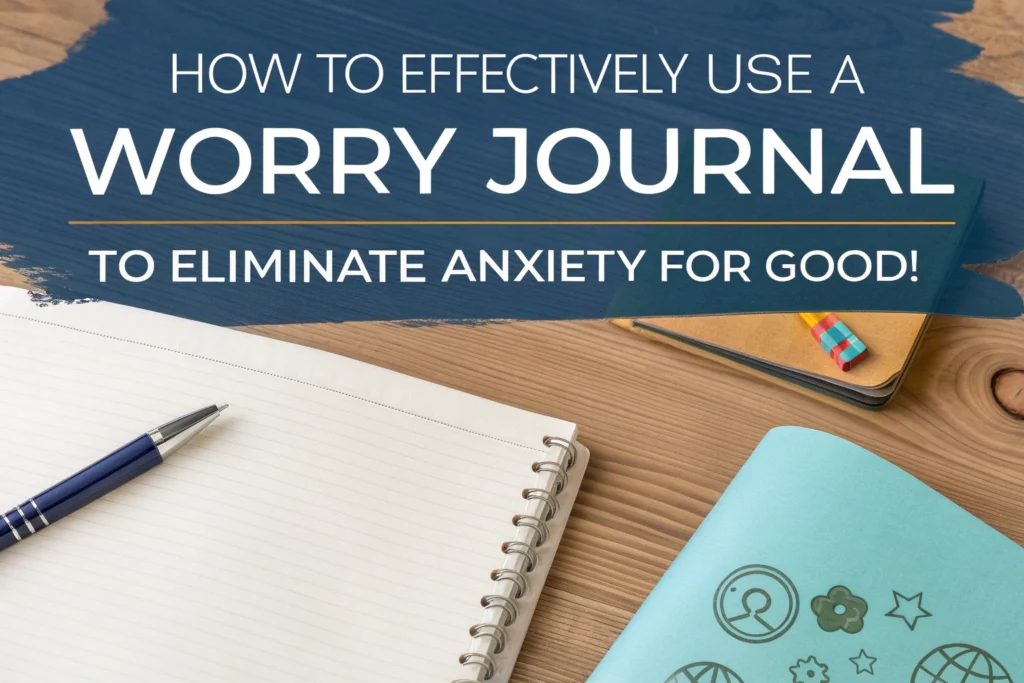Introduction: Your Secret Weapon Against Anxiety
You know that feeling—your heart races, your thoughts spiral, and suddenly, you’re drowning in “what-ifs.” Anxiety doesn’t just steal your peace; it hijacks your entire day. But what if you could stop anxious thoughts in their tracks before they take over?
A worry journal isn’t just another notebook. It’s a scientifically backed tool that helps you:
- Detangle chaotic thoughts
- Spot anxiety triggers
- Replace fear with logic
- Regain control of your mind
In this guide, you’ll learn exactly how to use a worry journal to dismantle anxiety—step by step. No fluff, just proven techniques that work.
Table of contents
What Is a Worry Journal? (And Why It Works Better Than Regular Journaling)
The Problem With “Just Writing It Down”
Regular journaling helps, but when you’re anxious, unstructured venting can fuel rumination. A worry journal is different—it’s a structured system designed to:
✔ Interrupt obsessive thought cycles
✔ Challenge irrational beliefs
✔ Create actionable solutions
The Science Behind It
Research shows expressive writing (like worry journaling):
- Lowers cortisol (stress hormone) by 19% (University of Texas study)
- Reduces intrusive thoughts by 35% (Journal of Anxiety Disorders)
- Improves problem-solving clarity (Harvard Medical School)
Key difference: Unlike a diary, a worry journal forces you to engage critically with fears instead of just replaying them.

How to Start Your Worry Journal: A Step-by-Step Blueprint
Step 1: Choose Your Format
| Option | Best For | Drawback |
|---|---|---|
| Pen & Paper | Mindfulness, memory retention | Less portable |
| Digital App | Searchable entries, reminders | More distracting |
| Voice Notes | Quick capture when overwhelmed | Harder to organize |
Pro Tip: Use a small notebook you can carry everywhere—anxiety doesn’t wait for “the right time.”
Step 2: The 3-Column Method (The Core Technique)
This is where the magic happens. Every entry should have:
- The Worry
“What if I get fired for missing that deadline?” - Reality Check
- “My boss gave me an extension last time.”
- I’ve never lost a job over a single mistake.
- Action Plan
- Send the boss a progress update email today.
- “Set phone reminders for future deadlines.”
Example Entry:
| Worry | Reality Check | Action Plan |
|---|---|---|
| “My friend hasn’t texted back—they’re mad at me.” | “They’re traveling. Last week they said they’d be offline.” | “Send a funny meme instead of overanalyzing.” |
Step 3: Set Aside Dedicated “Worry Time” (Seriously!)
- Set a 15-minute daily window (e.g., 6:00–6:15 PM)
- Save non-urgent worries for this slot
- Result: Your brain learns to postpone (and often forget) minor anxieties
Advanced Techniques to Supercharge Your Journal
1. The “5 Whys” Drill (Find the Root Fear)
Keep asking “Why?” until you hit the core fear:
- “I’m worried about the presentation.”
- “Because I might stumble.”
- “Because people will think I’m incompetent.”
- “Because I need their respect.”
- “Because I tie my worth to others’ opinions.” ← Bingo.
2. Anxiety Triggers Tracker
Log this weekly:
| Date | Situation | Physical Symptoms | Intensity (1–10) |
|---|---|---|---|
| 5/10 | Work meeting | Sweating, nausea | 7 |
| 5/12 | Family call | Racing heart | 5 |
Spot patterns: “My anxiety spikes Sundays at 8 PM—anticipating Monday.”
3. The “Worst-Case Survival” Hack
Ask:
- “What’s the absolute worst that could happen?”
- “How would I handle it?”
- “What’s more likely to happen?”
Example:
- Worst case: “I’ll go bankrupt.”
- Survival plan: “I’d sell my car, move in with my sister, and get a temp job.”
- Reality: “I have money saved and valuable skills I can use.”
Common Mistakes That Sabotage Your Progress
🚫 Venting Without Resolving
- Bad: “I’m so stressed about money!” (repeats daily)
- Good: “I’m stressed about money → Cancel Netflix, apply for 3 side gigs.”
🚫 Skipping the Action Column
- Without concrete steps, journaling becomes rumination.
🚫 Judging Your Worries
- Unhelpful: “I’m stupid for worrying about this.”
- Helpful: “This fear comes from my past job loss. What’s different now?”

FAQ: Your Top Worry Journal Questions
Q: How long until I see results?
- Immediate: Relief after writing (like “dumping” mental clutter).
- 4+ weeks: Noticeable reduction in baseline anxiety.
Q: Can kids/teens use this?
- Yes! Simplify columns:
- “What’s scary?”
- “Is it true?”
- “What can I do?”
Q: What if I forget to journal?
- Set a phone reminder: “10 PM—Worry Dump!”
- Miss a day? Just restart. Perfection isn’t the goal.
Conclusion: Your Anxiety Is No Match for This Journal
A worry journal isn’t about positive thinking—it’s about productive thinking. By organizing your fears, you:✅ Shrink them from monsters to manageable tasks
✅ Train your brain to problem-solve, not catastrophize
✅ Build proof that you can handle uncertainty
Your Turn:
- Grab any notebook.
- Write one worry using the 3-column method.
- Notice how much lighter it feels.
Anxiety whispers “what if,” while your journal speaks loudly with “what is.”
Call to Action:
Struggling with a specific worry? Share it below, and I’ll help you break it down using the 3-column method

